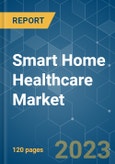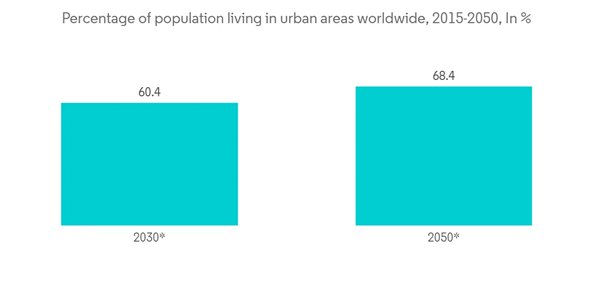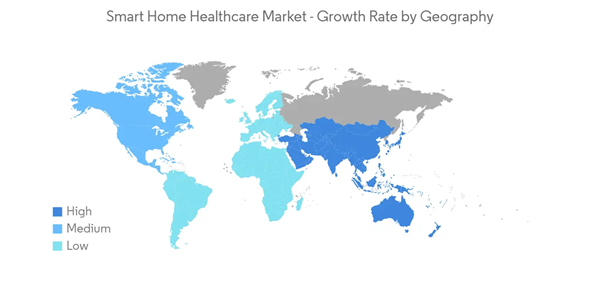The Global Smart Home Healthcare Market is expected to register a CAGR of 27.3% over the forecast period. The increasing adoption of IoT devices motivates the smart home healthcare market players to focus on launching such products. The potential for healthcare services to be provided in a smart home is growing alongside this trend.
In November 2022, Fall Detect by KamiCare, the globe's first Artificial intelligence fall detection and support solution available at home that doesn't need a pull alarm or wearable, was introduced by Kami Vision. Fall Detect by KamiCare, a division of Kami Vision, a machine vision firm that delivers AI solutions to corporate, SMBs, and consumers, detects and prevents senior fall risk through the use of inexpensive vision AI, two-way communication, private incident verification, and other features.
In August 2022, Care Connected Platform Anthropos announced an alliance with Vayyar Care, the world leader in 4D imaging, to expand Anthropos' abilities in active fall detection. Anthropos' Connected Care Platform monitors a variety of everyday behaviors of older persons in their homes using a set of discrete passive sensors, providing caregivers with the data to make better-informed choices. The new Vayyar Care alliance incorporates touchless radio frequency sensor technology, allowing Anthropos clients to deliver fall detection without the use of wearable devices.
This product will be delivered within 2 business days.
Key Highlights
- Connected homes can also help hospitals increase efficiency, prioritizing cases based on urgency and freeing-up beds. 90% of the nation’s USD 3.3 trillion annual healthcare expenditure is spent on individuals with chronic and mental health conditions, according to the Centers for Disease Control and Prevention.
- These patients would be helping hospitals save on monitoring and rehabilitation expenses by availing of services at home.
- Due to technological advancements, the self-care revolution has witnessed online pharmaceutical stores, telemedicine, and remote patient monitoring. Soon, smart homes will be the sources of primary care. Ongoing monitoring has been facing issues because the in-home care industry is expected to fill an estimated 4.7 million home care jobs, as per PHI. Then, Paul Osterman from MIT estimated that the LTSS field requires additional 13.1 million family caregivers from 2015 to 2040 and currently faces a shortfall of up to 11 million caregivers.
- A growing aging population leads to an urgent need to find ways to improve patient outcomes and access to care and reduce the overall cost. The active aging industry in the United States includes safety and smart-living technologies, health and remote care, and wellness and fitness technologies.
- Across the growing home healthcare field, the portability and dissemination of computerized patient records serve as a significant health data risk to interception by hackers, leading to the violations of the Health Insurance Portability and Accountability Act (HIPAA). Such violations could attract substantial penalties and fines for operators/device manufacturers and service providers across the smart home healthcare segment. As technology advancements continue in the home healthcare field, providers and their parent companies must balance potential risks against these technologies’ benefits.
- During the COVID-19 pandemic, connected health and RPM (remote patient monitoring) became more pervasive. These methods and services enabled physicians to monitor patients contactless, preventing the spread of the novel coronavirus. This facilitated them by increasing the bed space for patients with severe cases. Hospitals, since then, have been actively supporting the usage of connected health and RPM and fostering the same toward building a smart home healthcare lifestyle, even in the post-pandemic world.
Smart Home Healthcare Market Trends
Growing Importance of Health and Wellness and Exploring Relevant Areas to Drive the Market Growth
- Various government initiatives to enhance longevity facilitate the fast-paced growth of the global population. Most developed nations are increasingly observing a rise in the number of aging Populus.
- According to the WHO, by 2030, one in six people will be aged 60 years or over worldwide. The share of the population aged 60 years and over may increase from 1.0 billion in 2020 to 1.4 billion. By 2050, the world’s population of 60 years and older may double (2.1 billion). The population aged 80 years or older worldwide is expected to triple between 2020 and 2050 to reach 426 million.
- Consumers are increasingly adopting healthier diets and exercise routines to maintain a healthy lifestyle, and technology is helping maintain such a lifestyle in developed countries.
- Moreover, Schneider Electric, a well-known company in power management and automation, announced cooperation with Sendal Inc. in January 2023 to assist in better home air quality. The collaboration addresses a major issue that many people perceive as developing in both business and residential areas. As building envelopes grow more efficient, it takes more work to transport air inside such buildings. Many people believe that by making a building more efficient, it becomes less healthy for the people who live in it.
- The growth of smart living and smart cities’ concepts, due to the growth in urban population, will shape the market demand over the coming years, further facilitating the adoption of smart homes and living technology. Urban farming in indoor spaces using vertical and horizontal farming is expected to gain traction. It may help maintain a constant supply of healthy food for the growing health and fitness needs.
- Moreover, in-depth connected ecosystems focusing on wellness and management will offer industry and non-industry players the most significant opportunities. Although healthcare providers prefer developing in-house solutions, industry partnerships may help them establish therapeutic ecosystems that deliver value through multiple points of care.
Asia Pacific to Witness Highest Growth
- The digital transformation and the explosion in IoT devices aim to modernize healthcare delivery in the Asia Pacific healthcare market. Moreover, worldwide, manufacturers have been providing effective and affordable solutions, specifically for Asian smart homes. Within Asia, Taiwan, South Korea, and Singapore are countries depicting high data connectivity.
- According to the United Nations, there will be 366 million elderly Chinese people by 2050, which is much more than the present total U.S. population (331 million). By then, China's percentage of persons 65 and older will have increased from 12% to a predicted 26%. The country's smart home healthcare industry is likely to be driven by the country's growing older population.
- The region's rising generation of individuals growing up with technology promises a potential market adoption in the near term as critical barriers such as acquiring new technical skills will not remain. Similarly, healthcare tools are working on established platforms like WeChat, with billions of users across China and India.
- Market participants in the region are pursuing a variety of initiatives, which are projected to boost the region's smart home healthcare market. Ping An Healthcare and Technology Company Limited, for example, announced the purchase of Ping An Smart Healthcare, a Ping An Intelligent City business sector, in October 2022. Going ahead, as the Company pursues its unique model of "Managed Care + Family Doctor Memberships + O2O Healthcare Services," both firms are expected to generate business synergies, increase efficiencies, and expedite the creation of an integrated O2O health services network catering to health, sub-health, illness, eldercare management, and chronic disease in order to promote national health awareness and empower the "Healthy China 20" goal.
- As a result, China's smart home healthcare market is being driven by substantial healthcare infrastructure, urbanization, and improved healthcare equipment. The growing number of chronic patients is boosting the use of home healthcare services and products. The key drivers driving the China market are increased medical supervision, personalized healthcare services, and home medical equipment.
Smart Home Healthcare Industry Overview
The smart home healthcare market is consolidated. The companies are launching new products and leveraging strategic collaborative initiatives to increase their market share and increase profitability. Some of the recent developments in the market are seen as in December 2022, Aloe Care Health and Origin collaborated for an in-home safety solution for caregivers and seniors. Aloe Care will deploy new in-home safety mechanisms and a service feature to monitor falls and motion in the first half of 2023. The solution leverages Origin's unique WiFi Sensing technology and Aloe Care's powerful machine learning techniques, removing the requirement for cameras indoors or wearable devices.In November 2022, Fall Detect by KamiCare, the globe's first Artificial intelligence fall detection and support solution available at home that doesn't need a pull alarm or wearable, was introduced by Kami Vision. Fall Detect by KamiCare, a division of Kami Vision, a machine vision firm that delivers AI solutions to corporate, SMBs, and consumers, detects and prevents senior fall risk through the use of inexpensive vision AI, two-way communication, private incident verification, and other features.
In August 2022, Care Connected Platform Anthropos announced an alliance with Vayyar Care, the world leader in 4D imaging, to expand Anthropos' abilities in active fall detection. Anthropos' Connected Care Platform monitors a variety of everyday behaviors of older persons in their homes using a set of discrete passive sensors, providing caregivers with the data to make better-informed choices. The new Vayyar Care alliance incorporates touchless radio frequency sensor technology, allowing Anthropos clients to deliver fall detection without the use of wearable devices.
Additional Benefits:
- The market estimate (ME) sheet in Excel format
- 3 months of analyst support
This product will be delivered within 2 business days.
Table of Contents
1 INTRODUCTION
4 MARKET INSIGHTS
5 MARKET DYNAMICS
6 MARKET SEGMENTATION
7 COMPETITIVE LANDSCAPE
Companies Mentioned (Partial List)
A selection of companies mentioned in this report includes, but is not limited to:
- Sleepace
- Awair Inc.
- Eight Sleep
- Encore Healthcare
- Medtronic Plc
Methodology

LOADING...










